This is a look at Michael Jordan’s logo and some history behind his legacy.
Can a player become a product? And if so, when can the player become a product? There are hundreds of thousands of players in the world and different sports. Yet, only a handful of few become legendary, and their names become idolized.
There are uniquely fewer athletes who become products. For a player to become a product, he must show what I called the exceptional—Ts. It entails talent, training, tenacity, and triumph over every obstacle. Yes, that’s how a player becomes an iconic brand.
Michael Jordan is one such athlete who has evolved from a basketball player into a brand celebrated worldwide. The adept athlete has inked his name in the history books, and his fame has earned him a unique emblem. Jumpman is the official name of his trademark.
Jumpman is one of the most iconic signatures globally, specifically in the athletic footwear industry. It represents the zeal, dream, and achievements of Michael Jordan. In truth, the logo depicts an abstract image of the athlete in a unique jump.
With legs spread apart and the ball in the left hand in flight, the emblem captures Jordan in a position of dunking the ball in the basketball ring. Today, you can see the Jumpman logo on all branded products.
Who Designed Michael Jordan’s Logo?
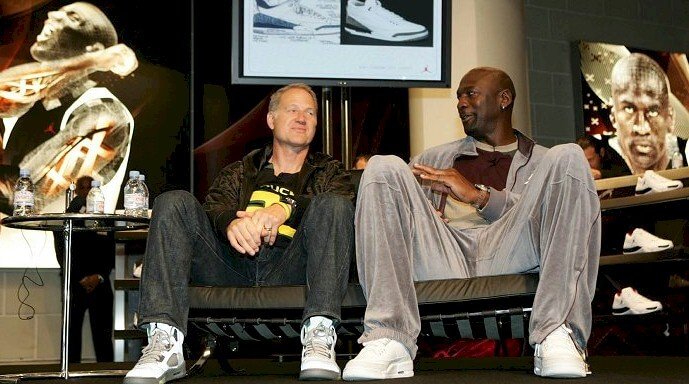
Nike Inc. owned the patent right to the Jumpman logo design. Nike is an American sportswear firm that designs, develops, manufactures, and markets footwear, clothing, equipment, and accessories worldwide. You can locate its headquarters in Oregon, Portland.
Before the Jumpman emblem hit the sporting scene in 1988, Michael Jordan had had a similar posture of a photo in Life Magazine. The picture shows the talented athlete in an Olympic jumpsuit and soaring towards a basketball rim. He performed a ballet jump movement.
Peter Moore, head of design at Nike Inc., discovered this stylized image of Michael Jordan. Because of copyright issues, he and his design team couldn’t use it. So, they tried to recreate other versions by taking inspiration from that. With Jordan in his Bulls colors, they experimented.
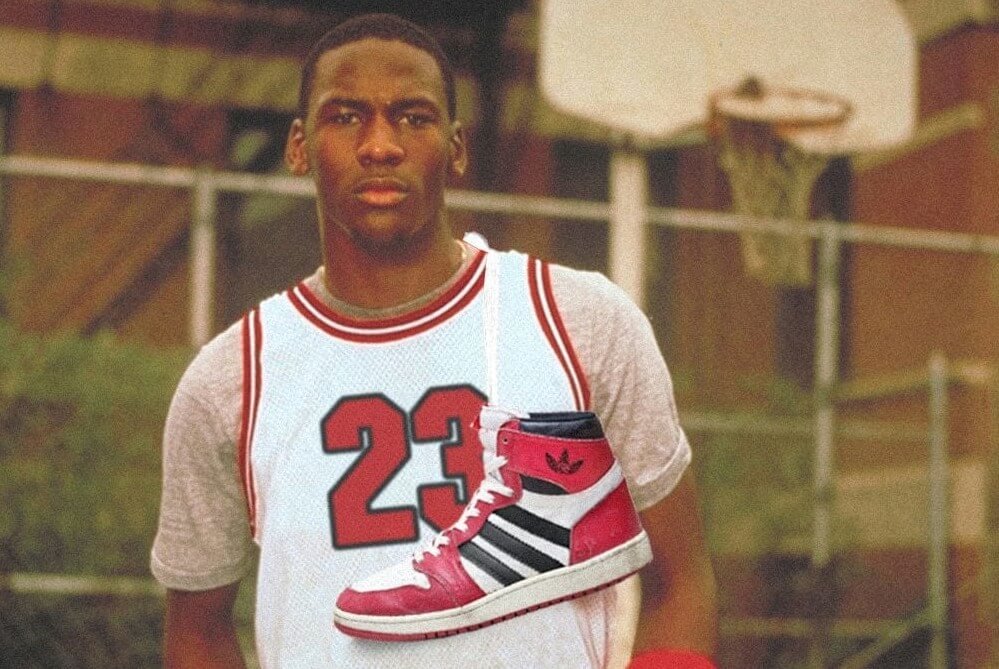 When Peter Moore left Nike, Tinker Hatfield replaced him. In 1988, the Jumpman logo came out. With some sketch concepts left behind by Peter Moore, Tinker created the Jumpman signature Jordan emblem. It was likable and quickly became recognizable than the previous ones.
When Peter Moore left Nike, Tinker Hatfield replaced him. In 1988, the Jumpman logo came out. With some sketch concepts left behind by Peter Moore, Tinker created the Jumpman signature Jordan emblem. It was likable and quickly became recognizable than the previous ones.
The Air Jordan III was the first Jordan shoe to have the Jumpman logo trademark. It replaced the original wing logo on Air Jordan I and II. Everyone, including Jordan, was impressed with the iconic designs, both the shoes and the logo.
Nike has had several partnership deals with elite athletes across the world. From basketball to tennis, you’ll find Nike’s endorsements with top athletes. Carl Lewis, Ronaldinho, and Tiger Woods are some examples. Others are Neymar Junior, James LeBron, and Cristiano Ronaldo.
Why did Michael Jordan’s Logo work?

It’s a reality that the first impression counts. Michael Jordan’s logo exudes love at first sight. Mr. Tinker and his team of designers went the extra mile to make the trademark effective. Together, let’s look at the factors that made the Jumpman so iconic and timeless:
- The Logo Design is Simple:
There are no intricate graphic elements aside from the player in flight. It’s so clean that even a child can identify it without second-guessing it. This is a powerful feature that separates the world’s top logo designs from the rest. The Jumpman logo, with its modest persona, is attractive.
- The Logo Design is Consistent:
The more brands expose you to a specific ad over time, the more it sticks with you. That’s a fact about advertising. The trademark, since it came into force about three decades ago, has changed little. It has remained consistent with its message and earned the loyalty of its cherished fans.
- The Logo Design is Versatile:
Well–crafted logos are malleable. It means they can take different forms without deviating from their primary objectives. The Jumpman logo can take on any color and remain highly recognizable. It can also scale on all marketing mediums to connect with fans.
- The Logo Design is Memorable:
The minimalist look of the Jordan emblem makes it hard to forget. Whether it appears in red, white, or black, the millions of people who see the Jumpman can’t miss it. The stylized posture of the abstract image stands out from the noise, making it timeless.
- The Personality Behind the Logo:
A winning personality attracts people effortlessly. Yes, people in every aspect of life want to associate with winners. You’ll find this in business, sports, music, politics, and almost every industry. Michael Jordan, with his style of play, was a winner with infectious charisma. This has also contributed immensely to the success of the Jordan logo and its range of products.
Graphic Elements of Michael Jordan’s logo
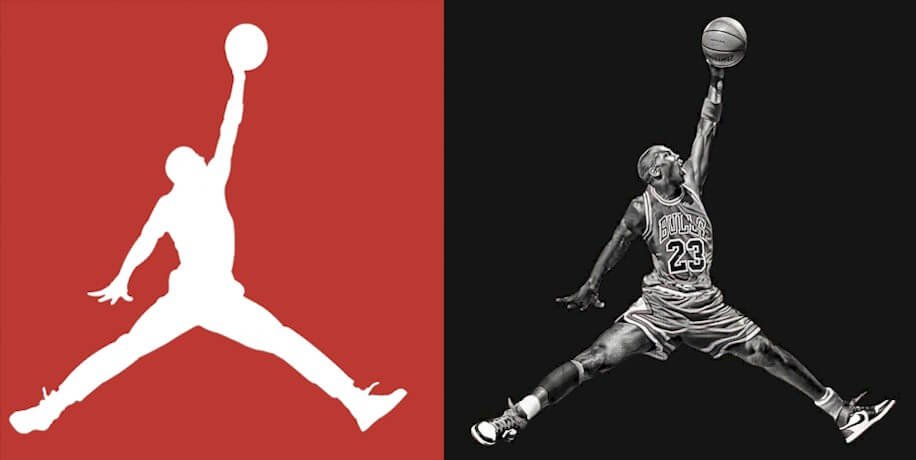
Can a graphic artist design a trademark without the elements of design? The answer is a resounding no! Visual elements are the soul of every creative work in existence. So, their absence means the end of all objects.
So, Mr. Tinker focused on some vital elements when crafting the trademark for Michael Jordan. He used the abstract image of Michael Jordan in an iconic position, a color palette, and no typography. Kindly read on as we explore the elements of design used in the iconic emblem:
Michael Jordan’s Logo Shape and Symbol:
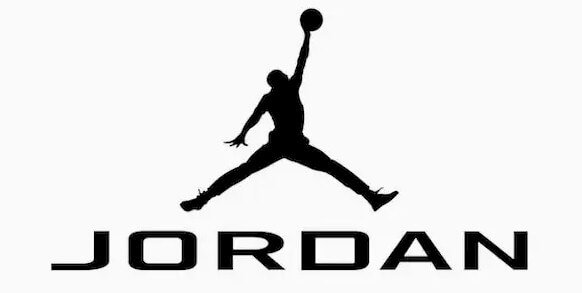
- A Circle:
The famous Michael Jordan Jumpman logo symbol has a rounded object. In reality, the circle represents a basket. It’s the official leather object used for such contests. You can also relate the rounded shape to the rim that basketball players aimed to score. A circular object also captures a sense of unity and communities. We can connect it to spectators, players, and managers of the game.
- A Jumping Man:
The iconic Jordan logo had its nickname, Jumpman, from the pose of the jumping man. It’s the most captivating design elements in the emblems. Clearly, it shows Michael Jordan as a player in action. The stylized posture has appeared twice. The first one featured him in a US Olympic outfit before the 1984 Olympic Games. And in 1985, he posed for a similar shot in a Chicago Bulls outfit and Nike Sneakers.
- The Stretched Legs:
The two stretched legs offered a balance to the man in flight. When they turn upside down, they mimic the letter—V. As the 22nd letter of the English alphabet, it’s symbolic of the career advancement of Michael Jordan. As a player, Jordan displayed many traits related to the letter—V. He was valuable, versatile, and always aimed for victory. He was also a visionary athlete who exercises vigilance and vigor.
Michael Jordan’s Logo Colors:
- A Black Color:
The highly praised Jordan’s logo has black as one of its hues. It can feature either as a background color or on the actual image. This depends on the medium the company wants to use to promote its range of products. When there is no light, the color black takes place.
Black has both negative and positive effects on the moods of people. Power, authority, and elegance are some cheerful tones of black. In contrast, it can stand for fear, death, and evil. However, the Jumpman’s logo used the hue to convey leadership, formality, and strength.
- A White Color:
White is the next neutral color you can spot on Jordan’s signature trademark. Just like the black color, it can beautify either the image or the background. The two are powerful, contrasting colors. The color of snow represents purity, humility, and simplicity.
Brands can also use it to convey safety, cleanliness, and loyalty. To a large extent, white color affects our minds in positive ways. It promotes freshness, clarity, and renewal of strength. But too much of it on the eye can blur vision.
- A Red Color:
Red is one primary color that also inked Jordan’s trademark. It’s everywhere! It’s the color of blood, ripped tomatoes, apples, and strawberries. Brand experts use the color red to send a feeling of love, passion, desire. They also use it to communicate courage, vigor, and joy.
These are positive emotions of reds. Yet, the color can negatively affect your moods. These may include rage, anger, and danger. Others are wrath, stress, and lust. Red is an intense color for grabbing people’s attention quickly.
Michael Jordan’s Logo Typography
Fonts are a significant part of branding. They spell out the personality of the brand to stakeholders. But the Jumpman’s logo comes with no lettering. Well, it’s among the few iconic symbols that have bent the rules in their favor. Perhaps the designer excluded the name because he believed the athlete had a unique personality. This charismatic vibe followed the trademark.
The Impact And Legacy of Michael Jordan
Greatness compelled people to call you with names they think reflect your ability. Jordan’s many fans couldn’t help but praise him with iconic nicknames. His stellar performances on the court arena earned him names. Call him Mike or MJ, and you are referring to a genius.
On 17th February 1963, Michael Jeffrey Jordan was born. In Brooklyn, New York, James Jordan and Deloris Jordan welcomed a son. Larry, Deloris, Roslyn, and James Junior are his siblings. His mother was a bank teller and a writer, while the father was an equipment manager.
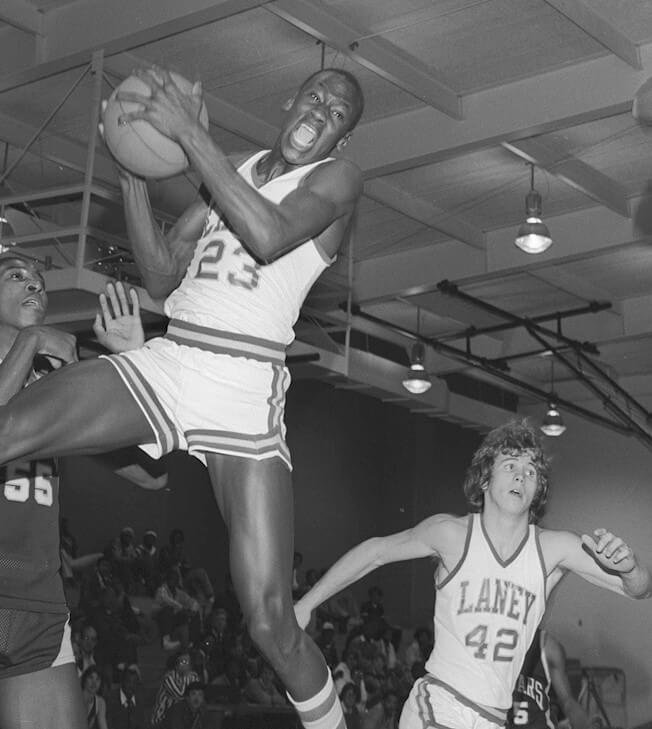
He attended Emsley A. Laney High School in Wilmington, North Carolina. At this stage of his life, he showed his passion for sports—basketball, baseball, and football. His father contributed to his interest in sports. He built a basketball in their backyard and also showed him how to play baseball. Sadly, two teenagers killed the father in the summer of 1993.
Jordan impacted Laney’s junior varsity team. In the team, he registered several 40 points. As a senior student, MJ played in the McDonald’s All–American Game in 1981 and scored 30 points. In the same year, he got a basketball scholarship to study at the University of North Carolina. In 1986, he gained a Bachelor of Arts degree in geography.
In 1984, Jordan started his professional career when the Chicago Bulls drafted him. He was the third pick behind Hakeem Olajuwon (Houston Rockets) and Sam Bowie (Portland Trail Blazers). Skillful players like John Stockton and Charles Barkley were part of the draft.
He made his rookie season count. On 51.5% shooting, he scored 28.2 points per game for the Chicago Bulls. His contribution helped the team to make the playoffs. They finished at 38–44. Eventually, he won the NBA Rookie of the Year Award and was nominated for the All-Star Game.
Michael Jordan was unlucky in his second season. After only three games, he got his foot broken. That caused him to miss 64 games. However, his team made it to the playoffs with a record of 30–52. It was the worst record in NBA history.
He recovered and came back even more potent. He set an unbroken record in a playoffs game with 63 points in Game 2 against Boston Celtics. On records, most people considered that 1985–86 Celtic team as one of the greatest in NBA history.
In the 1986–87 season, he had one of his best games, averaging 37.1 points on 48.2 % shooting. This translated to over 3,000 points, earning him the bragging right after Wilt Chamberlain for such incredible points. He also recorded 200 steals and 100 block shots, the first in NBA history.
His contributions were phenomenal to the rise of the Bulls. By the late 1980s, the squad had become a winning team. Jordan won his first MVP Award during the 1987–88 season. He ended up recording 35.0 points per game on 53.5% shooting. It was the beginning of more laurels.
 Mike, the black Jesus, won his second MVP in the 1990–91 season. Here, he averaged 31.5 points on 53.9% shooting. For the first in 16 years, the Bulls placed first in their division with 61 wins in the regular season.
Mike, the black Jesus, won his second MVP in the 1990–91 season. Here, he averaged 31.5 points on 53.9% shooting. For the first in 16 years, the Bulls placed first in their division with 61 wins in the regular season.
They advanced to the NBA Finals, where they defeated the Lakers in four games to one. The Lakers team had legendary players like Magic Johnson and James Worthy. The Bulls won the trophy, and Jordan won the NBA Finals Most Valuable Player for the first time.
The Bulls found their rhythm in the league, and Jordan became a household name. He helped the US Olympic basketball team to win gold in 1984 and 1992. He has also won the NBA championship six times and six times voted as the NBA Finals MVP.
These are just a few of his superb contributions to the game of basketball. He has retired three times—from 1993, 1998, and finally in 2003. His 19 years of professional career have been colorful, earning him names like Black Cat, His Airness, GOAT, and Air Jordan.
Summary of Michael Jordan’s Legacy
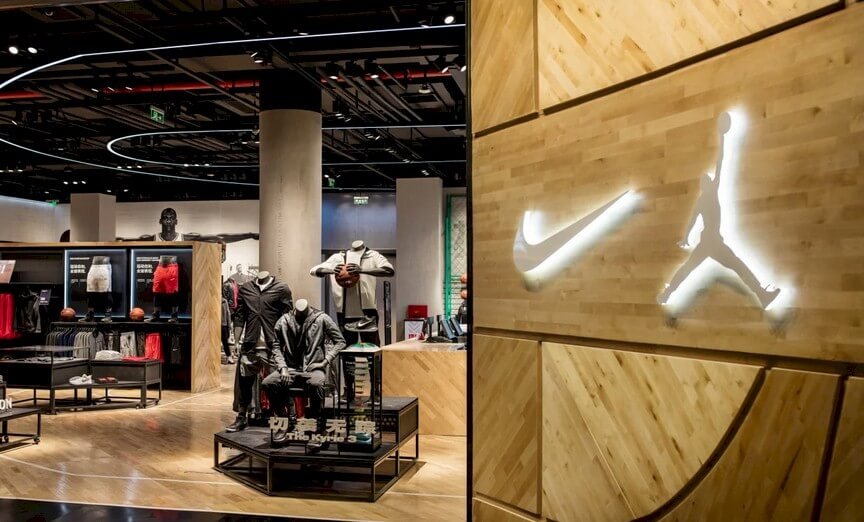
MJ is one of the most decorated athletes in the game’s history. For him to play football, baseball, and basketball shows a man who loves challenges. He now owns a controlling stake in Charlotte Hornets. With this investment, he became the first ex–NBA player to run one of the league’s franchises.
 As a profit-oriented company, Nike wouldn’t have partnered with him if he wasn’t extraordinarily talented. And the success of his Air Shoes confirmed that Nike made a good deal. According to Forbes, the Jordan brand generated $1 billion in sales for Nike in 2010.
As a profit-oriented company, Nike wouldn’t have partnered with him if he wasn’t extraordinarily talented. And the success of his Air Shoes confirmed that Nike made a good deal. According to Forbes, the Jordan brand generated $1 billion in sales for Nike in 2010.
Jordan’s winning mentality, work ethic, and willingness to listen to advice shot him to fame. Again, his incredible performances on the court brought success to him, and the club never witnessed in a long while. Finally, the Jumpman logo has mirrored his professional career most effectively.







